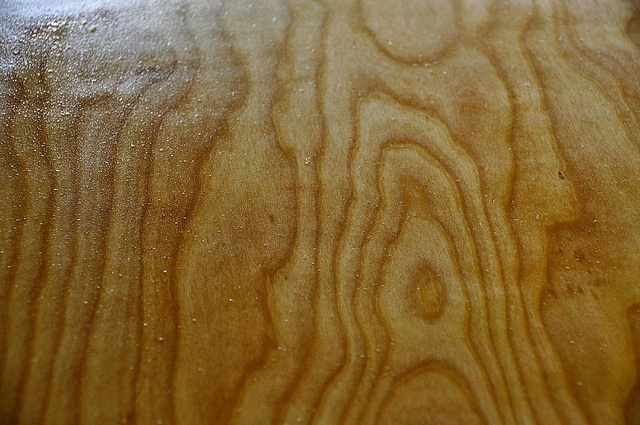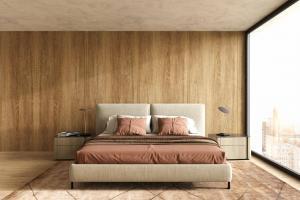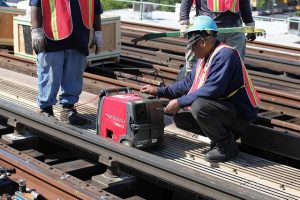Normally when we think of sandblasting, we think of working on machinery, rusted equipment and even artistic design work in stone. But sandblasting is used for much more delicate work as well, including etching glass. There are few hard materials that can’t be sandblasted to some benefit, as long as the right air pressure and blasting media is used.
There are a wide range of potential blasting media available; some of them common as sand, while others are a bit more exotic, like ground nut shells, plastic and even crushed glass. Each has its own peculiarities, including which materials they work best with. Even for one material, such as wood, different blasting medias will produce different results.
So, this brings us to our basic question: Can you sandblast wood? The quick answer to this common question is “Yes!” There are quite a few methods to consider, depending on the type of wood as well as the type of project you’re considering. This guide describes how to sandblast wood, and it provides tips for sandblasting wooden furniture as well. Note that you can use the techniques described here for sandblasting cabinets, as well. Let’s get started.
How to Sandblast Wood
Whether sandblasting wood furniture or sandblasting wood before getting started with a project, there are a few things that you’ll need:
- Sandblaster
- Ceramic nozzle
- Air compressor
- Sandblasting media
- Blast hood
- Protective gloves
- Tyvek coveralls (optional)
Once you have gathered all of your materials, it’s time to get some practice before you start to work on your project. We’d like to stress beforehand just how important it is to take your time and get a feel for the process before you get started, since there’s a very narrow margin for error. Once material has been removed through sandblasting, it can’t be put back on, just like cutting a board. Remember that the wood you are going to be working with varies in density, both due to grain and due to irregularities, such as knotholes. So sandblasting results can vary as well.
Setting up a Work Area
For small projects, a glove box is an ideal environment for sandblasting. But there are few things made of wood, which are small enough that you are likely to be able to sandblast them in a glove box. For these, it’s common to use a well-ventilated sandblasting booth; an area specially set up for sandblasting. If you don’t have one of these available to you, it’s best to do this project outside, away from any structure or vehicle that might be accidentally damaged by the pressurized media.
You can make a sandblasting booth out of plywood, assuming you have enough room in your workshop to make on. It is essentially an enclosed area, much like a paint booth. The main difference is that you won’t want to be painting in this booth, as it will end up with a lot of blasting media in it, which could end up in your paint.
Another way to make a sandblasting booth is to use plastic tarps as curtains, attaching them at the ceiling and weighting them at the floor by attaching them to a 2”x 4” or pieces of scrap wood. Be sure to have overlapping seams between the tarps, especially for your doorway.
You’ll want to have good lighting in the sandblasting booth, as the blasting process generates a lot of dust, making it hard to see.
Keep in mind that sandblasting is a messy process, as the blasting media you use will end up on the ground and all over everything in the near vicinity. If you’re only doing an occasional sandblasting job, this isn’t much of a big deal. But if you’re going to be sandblasting a large amount of work or sandblasting regularly, you might want to think of having some way of cleaning up your blast media, such as using a shop vac.
Soda Blasting
Soda blasting has gained a lot of popularity in recent years. This is a sandblasting process, where baking soda is used as the blasting media. Although lightweight and “soft” to us, the individual pieces of soda have sharp edges, making them an excellent abrasive. It is one of the few blasting media that is biodegradable, eliminating much of the need for cleanup. Nevertheless, it can be harmful to plants, so if you are soda blasting outdoors, you will want to either rinse away or vacuum up as much soda as you can.
Soda is the most common blasting media used with wood. However, you want to be sure that the equipment you are using it with is intended for use with soda. Some manufacturers are selling cheap sandblasting cabinets, labeled as “soda blasting cabinets.” These really don’t take into consideration the needs for soda blasting and are nothing more than low-quality cabinets which will not last.
For occasional blasting jobs, a handheld blaster is sufficient. However, it should be noted that these smaller units are slower to work with, as they don’t put out as much abrasive media. This probably makes them ideal for the novice, but as you gain experience, you will probably want a better unit.
The Sandblasting Process
Set up your sandblaster according to the manufacturer’s instructions, and fill the pressure tank or pot with sandblasting media such as corn cob, walnut shells, or soda. Note that heavy media like corn cob and walnut shells are highly abrasive, while soda is gentlest. The media you choose will have an effect on the finished appearance of your project.
Ensure that you have chosen the correct ceramic nozzle for your sandblaster. Walnut shells, pumice, and other tough media typically call for a 1/8 inch nozzle, while soda blasting wood calls for a 3/32 inch nozzle.
Don your protective garb. Do not skip this step, as the abrasive material being used for your project can remove skin and cause serious injuries. It’s a good idea to wear a pair of Tyvek coveralls with tape securing the openings. If this isn’t possible, cover up all exposed skin with durable work clothes. Be sure that you are wearing clothing with long sleeves. Wear pants, not shorts, and be sure that you’re wearing durable, closed-toe shoes.
Whether you use a sandblaster or soda blaster, understand that wood will warp if the pressure is too high. Be sure to read the instructions that came with your sandblaster. In most cases, the air compressor’s pressure should be set at 35 pounds per square inch.
Start by testing your sandblaster on a piece of scrap wood. Holding the sandblasting gun so its nozzle is about 8 inches from the wood’s surface, pull the trigger and slowly move the nozzle back and forth. Try not to overlap passes by more than about ¾ of an inch.
Stop and inspect your test piece to see how it turned out. You’re looking for problems like pitting, unevenness, and blown-out chunks. If you see any defects, try your test again, moving further away from the wood’s surface. Once your test piece shows no defects, you know you’ve got the correct distance and you can move on with your project.
If you have the opposite problem – that is, if you’re not noticing an effect, then you can turn up the pressure on the air compressor in 10 PSI increments. Repeat the test until you’re satisfied with the outcome, and then move on with your project.
Making Your Own Sandblaster
While sandblasters aren’t all that expensive, there are always those of us who prefer to make things ourselves. Since a sandblaster is actually a very simple device, this is one place where we can make our own tools fairly easily. The type of sandblaster we’re going to make would be more accurately referred to as a pencil blaster for the size of the area covered.
To make the sandblaster, you’ll need an air blow gun, of the type that is used for blowing compressed air to clean out dust and dirt. You can purchase one with a four inch nozzle for about five dollars. The thin nozzle is important for the working of the sandblaster. You’ll also need a soda bottle.
Before anything else, clean and dry out the soda bottle and assemble the air blow gun. Then chuck the gun up in a vice and cut away about ¼ inch of the top side of the nozzle, about halfway along its length. Please note that this has to be on the top side of the nozzle for the sandblaster to work, so don’t try making the hole in the nozzle first, then assembling the gun.
Remove the retaining ring for the soda bottle’s cap and drill a hole through where it was, which is the same diameter as the air gun’s nozzle. The nozzle needs to fit tightly through this hole. When the gun is held for use, the bottle should be upside-down, looking much like a top-hopper paint spray gun.
To use the sandblaster, stand the bottle upright, with the cap removed. This will have the gun upside-down. Fill the bottle with the blasting media and recap it tightly. Turn it back over and connect to air.
The air stream coming through the nozzle will pick up blasting media as it passes by, the same as any commercial sandblaster. Media will be gravity fed into the air stream, providing a continuous stream to clean or texture whatever surface you are working on.

Sandblasting to Create Effects in the Wood
Sandblasting can have several different effects on wood, depending on what media you are using and what you are trying to accomplish. While normally used for cleaning, sandblasting can also be used on wood to bring out the grain in the wood, especially when trying to create an artificial weathered barnwood effect, or to be used in conjunction with carving for architectural trim or signage.
The basic idea here is that the blasting media has a greater effect on the soft part of the wood’s grain, than it does on the hard part. So it will carve out the softer part, leaving the hard grain. The effect is similar to using a wire brush on the wood, but considerably better, in that the grain left is even more pronounced.
To accomplish these sorts of effects, you’ll want to use a harder blasting media, such as walnut shell or even crushed glass, depending on how severe the aging effect you want on the wood. There is a bit of an art to this, so you’ll need to use a combination of finding the right media and blasting for the right amount of time, at the right distance, to get the effect you want.
You will probably also want to combine the distressing you do with the sandblaster with other techniques, such as using an awl to create authentic-looking worm holes and a grinder to create what looks like saw marks. A grinder can also be used along the edges to give the impression that the board is old enough to have lost some of the original material, in addition to what you are removing through the sandblasting.
Artistic Sandblasting with a Pencil Blaster
The pencil blaster is the sandblaster equivalent of an airbrush, allowing you to do detailed work with via sandblasting. It is ideal for cleaning small objects and etching operations, whether in wood, glass or metal. It is ideal for cases where you are combining detailed design work with the idea of distressing the wood. Please note that the small size of the blast stream will mean that you’ll only be getting a small amount of blasting media, so you won’t be getting deep penetration into the wood surface.
Sandblasting Furniture
Sandblasted wood furniture can be smooth and beautiful, so long as you’re very careful and you take time to practice your technique before working on anything truly important.
There are a few reasons to sandblast wood furniture: Perhaps you’d like to give it an old, rustic, or weathered appearance, or maybe you’d like to create a piece that looks like it’s made with real driftwood that has spent months or years exposed to the ocean’s salty waves. Maybe you’d simply like to remove a thick coat of paint so that you can refinish that old chest, chair, or cabinet that’s been begging for a makeover. Whatever the reason, sandblasting wood furniture of different types calls for the same basic steps.
Now is a good time to mention that sandblasting antique furniture might not be in your best interest, depending on your goals. If you want to try soda blasting or sandblasting a vintage piece of furniture with the aim of restoring it, understand that the wood underneath the finish might emerge badly damaged. Test a hidden area if you can. If, on the other hand, you have a piece of antique furniture that you’d like to turn into a rustic, distressed masterpiece, then sandblasting or soda blasting might be the perfect technique to use.
The best way to sandblast wood furniture is usually to use soda as the media. The “soda” in question is the same as baking soda used in the kitchen. It’s great for removing paint easily, and it won’t cause as much damage to the underlying wood as other media can. Of course, you can always experiment with walnut shells or plastic media, if you like.
The sandblasting process typically moves very quickly, especially when being used to remove paint. It’s easy to overdo it and end up with a project that needs to be re-sanded the old-fashioned way before finishing, so work slowly and carefully.
One of the biggest problems people encounter when sandblasting wood furniture, signs, and other projects, is that wood isn’t the same hardness all the way through. The sandblasting media cuts through the softest portions of the wood first, leaving the harder portions exposed. This can create a very cool artistic effect that looks a lot like natural driftwood, but the same effect can be problematic if it’s not exactly what you’re going for.
Don’t feel bad if your test projects aren’t perfect on the first go. Sandblasting wood furniture is a specialized technique that takes plenty of practice and even skilled operators sometimes encounter problems. Take your time, enjoy the process, and have fun experimenting!



